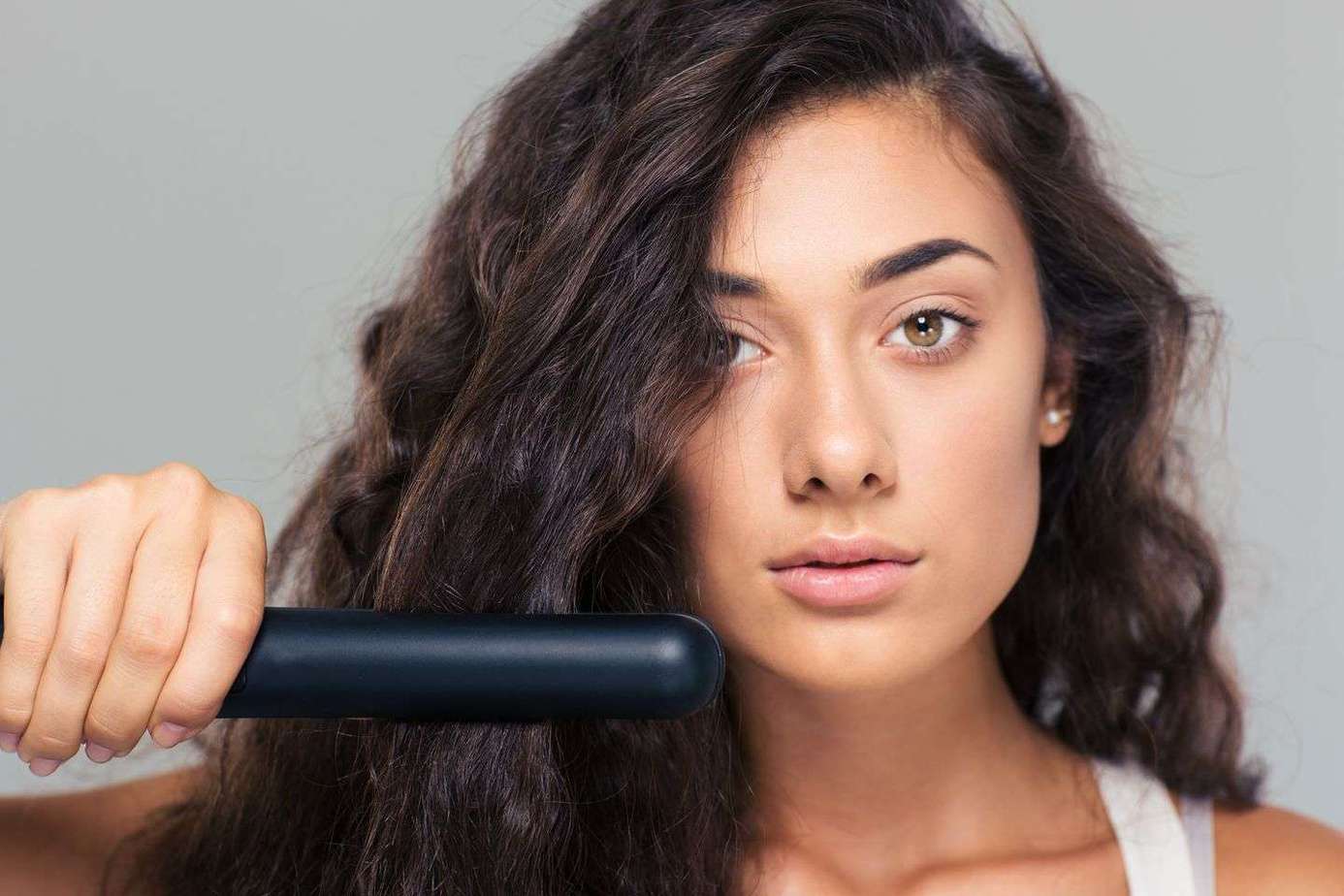No one is ever satisfied with what they have. Especially, when it comes to women our hair bothers us a lot. It is funnily said that girls who have straight hair want curly hair and girls who have curly hair want straight hair. This is how straighteners and curlers came into action. The style our hair gorgeously and leave behind a shine. Different hairstyles and extra smoothness, what else could anyone ask for?
As always there is another side to this story. The luster and softness are temporary, but the damage they cause is permanent. For preventing this and to keep the natural touch of hair constant you can use a heat protectant.
It is a serum or a lotion that acts as a shield over the hair and protects it from the external heat. Commonly the heat is referred to as from flat irons and curling irons which can snatch the natural oils of our hair.
Benefits of using hair heat protectant
There are numerous benefits of this hair healer cum protector. This product is a boon to the hairstyling industry as it keeps up with the loss in natural hair benefits.
- Heat protectant can be called as hair sunscreen. It covers the hair with a layer that protects it. The layer is responsible to keep away heat from the cuticle of the hair strand.
- The protectant has another purpose than protection. This serum works as a hair moisturizer and doesn’t let the natural hair oils to evaporate.
- It is used to avoid hair dehydration and dryness. Very useful for dry hair as it remains for long hours and is easy to apply. Hair heat protectant replenishes the moisture lost due to heat styling.
- Use it before you apply a straightening iron or a curling iron as the styling gets easy and the health proportions remain intact. Plus, the straightening or curling stays for a longer time.
- It can reduce hair damage tremendously if applied before and after hair coloring or bleaching. Even if the hair-color is natural, it has some side effects. This protectant will overcome them and make hair as good as new.
Also Check: Best Heat Protectant for Natural Hair | How to Regrow Edges
How effective are Natural Oils?
Our hair scalp has oil called sebum; it is naturally present in the skin. As it is not enough to keep the hair oiled, hair gets frizzy, dry, and itchy and start falling. So we need to externally apply natural oils which are essential for our hair. They effectively work on the betterment of hair. The benefits of natural oils are given as:
- Reducing hair fall: Natural oils when applied properly on the scalp reach the roots of the hair. The roots absorb the oil and get stronger and stay firm to keep the hair from falling.
- Blood Circulation: If you get an opportunity to get a head massage then grab it. When the scalp is massaged using natural oil then it enhances the blood circulation. This improves hair strength and stimulates good sleep.
- Removal of dandruff and lice: Due to the dryness hair can develop dandruff. It is a fungal infection which makes the hair itchy. And if you come across the unfortunate lice in your hair then we recommend start using essential oils immediately.
- Heat Protectant: Yes, they are natural heat protectants which work fine. This point will be discussed further in the article where we have some tricks to use natural oils as heat protectants for hair.

Types of hair heat protectants:
There are many hair protectants in the market. Many brands launch one every day with fragrances. They are classified in two types:
Natural Heat Protectants: These types of heat protectant only have natural ingredients present in them. They prove to be better because there are no side effects after applying.
Overall they work great but work a little slower than the chemical or synthesised protectants. Although, it is always better to be on the nature’s side. Some of the natural oils such as coconut oil, castor oil, olive oil, almond oil etc. work as natural heat protectants.
Non-natural heat protectants: You will find them employed in a boutique or spa where people usually go for hair styling. Also they are widely available in the market. These hair heat protectants are used on an extravagant scale because they give instant results. You will get softer hair in no time.
But you are using a hair protectant to avoid problems and these products may cause them in the long run. But you should opt them if you are not frequently dressing your hair. Some of them are:
Diemethicone: Majorly used ingredient almost found in all the heat protectant products. This is basically silicone. The moisture trapping agent does the job well to get glossy and soft hair.
It keeps the hair strand cuticle flat, protecting it from the heat. It reduces the heat conduction through the cuticle. The moisturizing level is high so the hair does not frizz but it can get greasy at times thus spoiling the appearance.
Dmapa Acrylates Copolymer: This protectant coats the hair and creates a barrier. Used also for detangling and the hair quickly.
Hydrolysed Wheat Protein: This is mainly for moisture locking. It works nicely as a softener and this property makes it perfect for use while hair straightening. During permanent hair straightening or smoothening, this is sprayed to trap the moisture which could evaporate due to the heat styling.
These can also be found in sunscreen. They increase the SPF of sunscreen lotion and work in the same manner on the hair.
Natural Hair Protectant You can make at Home (DIY)
If you have an inclination towards making things on your own rather than buying stuff then this is for you. We have brought you a do it yourself (DIY) guide to make heat protectant at home. It is an easy process and will not cost you as much as buying it, will. So get ready to do some work as this process is going to make you.
1: Avocado Oil Heat Protectant
Avocado is a healthy food as well as a hair ingredient. It is rich in Vitamin E which nourishes hair till the tips. The lightweight oil does not let the hair get weighty and greasy. It works well for heat protection too. The DIY guide for using it is given below.
Things you will need:
- Spray bottle (Minimum 250 ml)
Ingredients:
- Water
- Avocado oil
Procedure:
- Pour about 200 ml of water into the spray bottle. Distilled water is preferred for the serum as it ensures no impurities. This serum will be thin so it is better to be used as a spray. That’s why spray bottle is recommended.
- Next, add 20-30 drops of the avocado oil to the bottle. Make sure the ratio of oil to the water should be 1:5 if you have thick and dry curly hair. You can lower the avocado oil amount if your hair is oily and vice versa. While heat styling the hair shouldn’t be oily but wet.
- Shake the mixture to mix the ingredients properly. Oil and water do not exactly mix but they have to be used together for the heat protection. So, shake it every time you are going to use it.
- Apply it to the hair nicely and cover up the cuticle.
This was an easy process. It could be used for shorter durations and have to apply often so we have some better ways to present.
2: Conditioner Heat protectant
Things you will need:
- Spray Bottle (min. 200ml)
Ingredients:
- Coconut oil
- Hair conditioner
- Almond Oil
- Distilled Water
Procedure:
- Pour 250ml of water in the spray bottle.
- Melt the coconut oil if frozen. You can keep its container in a hot water bath for a while to melt it.
- Add a teaspoon of coconut oil and later add drops of almond oil to the water. As oil is an immiscible liquid, shake it well so that oil and water can at least work together.
- The conditioner is put into the mixture next. Put a very small amount (coin sized) of conditioner. Any type of conditioner will do. It is added for the silicones in it. As we have discussed earlier, they help in heat protection for hair.
- Again shake the liquid mixture properly for the ingredients to blend in.
- Apply it to the hair for glossy and silky hair.
3: Aloe Vera Gel Heat Protectant
Aloe Vera acts amazingly well for the heat protection of hair. It has other benefits as well, hair growth, hair damage control and removal of dandruff. Using it can let you avail these benefits as well.
Although raw Aloe Vera is way more effective but using the gel is better for this spray, because naturally Aloe Vera doesn’t smell nice. This factor could hinder the chances of it as a perfect hair protectant. Fragrance is important as we are using it for enhancing our hair follicles and for that hair should look and equally feel good.
Things you will need:
- Spray Bottle
Ingredients:
- Aloe Vera gel
- Water
- Almond Oil
- Olive Oil
Procedure:
- Take the empty spray bottle and fill 3/4th of it with water.
- Add a few drops of olive oil in it.
- Then add about a 13g-15g or one teaspoon of almond oil to it.
- The remaining 1/4th bottle should be filled with Aloe Vera gel.
- Tightly close the spray bottle cap and shake the mixture inside. It may form lather or form at first but will be fine after the ingredients sit.
- Apply it nicely to the hair before colouring and blow drying.
4: Essential Oils with hair conditioner Heat Protectant
Things you will need:
- Glass Spray Bottle (strictly no plastic)
Ingredients:
- Coconut oil
- Almond Oil
- Hair conditioner
- Any one of the essential oils (choose according to your hair type)
- Water
Procedure:
- Fill half the spray bottle with water.
- Add 15ml of coconut oil (melted) and almond oil to it.
- Squeeze out some hair conditioner in the oil and water mixture.
- A few drops of essential oils such as geranium oil for dry hair, rosemary oil for oily hair and peppermint oil for thin hair. These are the prominent ones and easily available but you can consider some other oils too.
- As all the ingredients are in proper amount, mix it well.
- Spray it over hair whenever you get hair dressing.
Essential oils nourish your hair till the roots so this spray type can be used at any times. Whether it is a party or a walk in the sun your hair will be in check because of this heat protectant.
5: Shea Butter Heat Protectant:
Shea butter is used in all the moisturizing products. May it be lotions, creams, hair creams etc. It can be used as heat protectant too as it can also make hair shiny and less frizzy. The capability of moisturizing makes Shea butter a great ingredient to keep the moisture in the hair for a long time. It also has anti-oxidants and vitamins such as vitamin A, D and E.
Because of them Shea butter has SPF which provides sunscreen properties to it. It is easily available and cheap. Let’s see how you can use it to make a heat protectant yourself.
Things you will need:
- Bowl
- Refrigerator friendly container
- Hot plate
- Pan
Ingredients:
- Shea Butter
- Avocado oil
- Lavender Essential oil
Procedure:
- Take a pan and put 4 tablespoons of Shea butter on it. Keep it on the hot plate and let it melt properly. We are using a hot plate instead of the stove because we need the butter in semi-solid state.
- Once it is melted enough take it out in a bowl. Let it cool down. After that add the avocado oil to the butter. Mix it properly without disturbing the butter.
- Then add lavender oil and repeat mixing. Lavender oil is another essential oil that is suitable for any hair type.
- Take out the mixture in a container preferably a glass one and refrigerate it for some time. Don’t let it solidify.
- Blend the mixture to whip it. Whipped Shea butter is a magic content and works best.
- Once done apply it nicely on the hair.
The avocado helps in the whipping of Shea Butter. The essential oil is to keep the natural ingredients to the protectants. Shea butter can be called as natural silicone. It inhabits the properties of silicones and is way less expensive than them.
Natural Oils which can be used as Heat Protectant
- Coconut Oil: It is the best hair oil for any hair casualty. Be it hair fall, split ends, hair damage, it can be used. But the best part about it is the nourishing properties. It can be used on a regular basis. The penetrative and cooling nature of this oil is what makes it a god heat protectant. Though this oil shouldn’t be used in large quantities when it comes to heat hair styling. A few drops are good to go.
- Grape seed Oil: Probably the most suitable hair oil for a heat protectant. No additional ingredients are required, just the oil is enough to work well. The high smoke point of this oil doesn’t let heat pass through the hair. It makes the heat styled tresses soft and glossy. To add up it is homemade and easily available.
- Almond oil: This has properties similar to chemical heat protectant. Rich in vitamin A, B, C and E which is good for the overall health of hair. It also has a high smoke point which doesn’t let heat to make any contact with hair.
- Olive Oil: This is extremely softening for hair. But it is heavy and can make them greasy. Recommended for dry hair as a heat protectant.
- Castor Oil: Caster oil has many other benefits too. It can be used as a heat protectant but not for straightening, curly or blow drying. It cannot help you there. Castor oil can help as a heat protectant during summer and places where there is high temperature.
- Argan Oil: Known for its 220 degree Celsius smoke point this oil has everything a heat protectant should have. It can provide silky, shiny and soft hair alongside heat protection.
Substitute for Heat Protectant:
We saw that hair heat protectant is really necessary before flat ironing or blow drying but are they that needed? Will it be fine without them? Is there any way where you can avoid using them? Or you just don’t want to spend or work hard to prepare them.
Well there is away. Heat protectant is basically used for preventing hair damage from heat styling and also to keep the natural moisture of hair preserved. But as it adds moisture which is unfavorable for flat ironing this product may cause a problem. So there is a substitute for hair heat protectant.
Instead of using it you can just shampoo your hair with a non-sulfate shampoo. It won’t disturb your hair moisture and clean it from any impurities such as dust, pollutants, etc. Then apply the conditioner for deep conditioning. As discussed earlier conditioners contain silicones. They are also present in heat protectants of hair so hair conditioning after shampooing will fill up the shoes of silicones moisturizing.
Now there is no external moisture produced by an oil or spray which could be a threat to the hairstyle. And hair damage is minimal. All of this possible that to without a heat protectant! Exciting but don’t stop using them as they do more good than bad.


Shasha
Friday 8th of October 2021
I can make some DIY heat protection at home. But how long will it stay good for use?
Sanchita
Wednesday 8th of July 2020
Thank you so much for this information...this worked a lot for me. Great work!
Susan
Friday 10th of January 2020
Thanks for all the research and information on natural heat protectants!
Just a comment on #2 point (regarding avocado protectant) "While heat styling the hair should'nt be oily but wet." A "note" should be added not to use a flat iron on wet hair.
Sincerely, Susan